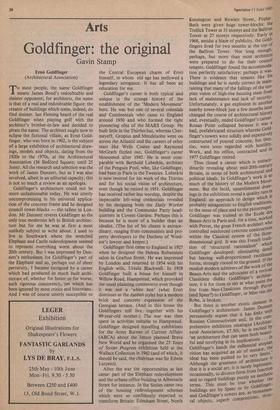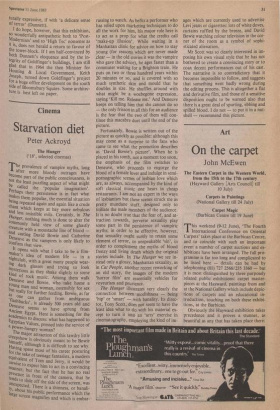Arts
Goldfinger: the original
Gavin Stamp
Erno Goldfinger (Architectural Association) To most people, the name Goldfinger means James Bond's redoubtable and sinister opponent; for architects, the name is that of a real and redoubtable figure: the creator of buildings which some, indeed, do find sinister. Ian Fleming heard of the real Goldfinger when playing golf with the architect's brother-in-law and decided to pirate the name. The architect ought now to eclipse the fictional villain, as Ernt, Gold- finger, who was born in 1902, is the subject of a large exhibition of architectural draw- ings, models and objects, dating from the 1920s to the 1970s, at the Architectural Association (36 Bedford Square; until 25 June). All the research and selection was the work of James Dunnett, but as I was also involved, albeit in an editorial capacity, this is not so much a review as an apologia.
Goldfinger's architecture could not be more unfashionable today. He was utterly uncompromising in his universal applica- tion of the concrete frame and he designed council tower-blocks — the tallest in Lon- don. Mr Dunnett reveres Goldfinger as the only true modernist left in British architec- ture but for me he was at first a most unlikely subject to write about. I used to live in Southwark where the wretched Elephant and Castle redevelopment seemed to represent everything worst about the 20th century. But I was impressed by Dun- nett's enthusiasm for Goldfinger's part of the Elephant and so, perhaps out of sheer perversity, I became intrigued by a career which had produced so much built archi- tecture of, whether for better or for worse, such rigorous consistency, yet which has been ignored by most critics and historians. And I was of course utterly susceptible to
the Central European charm of ErnO himself, in whom old age has mellowed a legendary arrogance. It has all been an education for me.
Goldfinger's career is both typical and unique in the strange history of the establishment of the 'Modern Movement' here. He was but one of several colonials and Continentals who came to England around 1930 and who formed the tight pioneering elite of the MARS Group. He built little in the Thirties but, whereas Cher- meyeff, Gropius and Mendelsohn went on across the Atlantic and the careers of other stars like Wells Coates and Raymond McGrath fizzled out, Goldfinger's career blossomed after 1945. He is most com- parable with Berthold Lubetkin, architect of the Penguin Pool, who, like Goldfinger, had been in Paris in the Twenties. Lubetkin is now revered for his work of the Thirties and for his social vision of architecture, even though he retired in 1951. Goldfinger has received rather less worship, despite the impeccable left-wing credentials revealed by his designing both the Daily Worker building and the Communist Party head- quarters in Covent Garden. Perhaps this is because he is more of a builder than an idealist. (The list of his clients is extraor- dinary, ranging from communists and pro- perty developers to the Duchess of Wind- sor's lawyer and keeper.) Goldfinger first came to England in 1927 when he designed the Helena Rubenstein salon in Grafton Street. He was impressed by London and returned in 1934 with his English wife, Ursula Blackwell. In 1938 Goldfinger built a house for himself in Willow Road, Hampstead, which provoked the usual planning controversy even though it was not a 'white box' (what Erni:5 dismisses as the kasbah style) but a modern brick and concrete expression of the Georgian terrace. (And in this house the Goldfingers still live, together with his 99-year-old mother.) The war was then spent in activities suitable to Hampstead. Goldfinger designed travelling exhibitions for the Army Bureau of Current Affairs (ABCA) about the future planned Brave New World and he organised the 25 Years of Soviet Progress exhibition held at the Wallace Collection in 1942 (and of which, it should be said, the chairman was Sir Edwin Lutyens).
After the war the opportunities at last came: part of the Elephant redevelopment and the urbane office building in Albemarle Street for instance. In the Sixties came two of the housing redevelopment schemes which were so confidently expected to transform Britain: Edenham Street, North
Kensington and Rowlett Street, Poplar. Both were given huge tower-blocks: the Trellick Tower at 31 storeys and the Balfron Tower at 27 storeys respectively. Early in 1968, amidst a blaze of publicity, the Gold- fingers lived for two months at the top of the Balfron Tower. Not long enough, perhaps, but more than most architects were prepared to do for their council tenants. Goldfinger found the accommoda- tion perfectly satisfactory: perhaps it was. There is evidence that tenants like his buildings and he is surely correct in main- taining that many of the failings of the uto-
pian vision of high-rise housing stem from lack of maintenance and lack of security. Unfortunately, a gas explosion in another nearby tower-block just a few months later changed the course of architectural history and, eventually, ended Goldfinger's career. Ronan Point collapsed because it was a bad, prefabricated structure whereas Gold- finger's towers were solidly and expensively constructed of poured concrete, but they too, were soon regarded with hostility. Work, and his office, contracted and in 1977 Goldfinger retired.
Thus closed a career which is extraor- dinarily revealing about mid-20th-century Britain, in terms of both architectural and political ideals. In Goldfinger's work is so much of the history of the Modern Move- ment. But the lucid, unsentimental draw- ings in the exhibition reveal a quality rare in England: an approach to design which is probably antagonistic to English traditions, to the sense of place and to the picturesque. Goldfinger was trained at the Ecowle des Beaux-Arts in Paris and, for a time, orked with Perret, the great French architect who controlled reinforced concrete construction within the Classical system of the three- dimensional grid. It was this French tradi- tion Gold finger developed: eliminating
tion of 'structural rationalism' but leaving well-proportioned rectilinear forms, strongly rooted to the ground. If the modish modern admirers of the work of the Beaux-Arts and the advocates of a revived Classicism dislike Goldfinger's architec ture, it is for them to say at what point the
Russian Constructivism and, Ferret lRinoehefroismbroNkeeo-n Classicism through (and Speer?) to Goldfinger, or Mies van der But there is another exotic element in Goldfinger's architecture. James Dunn.ett.t persuasively argues that it has links wlin ful and terrifying in its implications
the corn;
prehensive exhibition cataloguien Goldfinger's hands the millennial(Aructohpilebhe tural Association, £7.50), he is excited ty 'an architecture that can seem both beau vision has acquired an air of menace, .tts., ideal has been pushed to its very limi that itisa the social ari is of ar chlietge icttiunirtaei t eins, occasionally, to divorce form from funco
hetic
and to regard buildings purely on aest the terms. This must be true whether buildings are by Speer or by Golfinger, and Goldfinger's towers are, as monumen- tal objects, superb compositions,
turally expressive, if with 'a delicate sense of terror' (Dunnett).
I do hope, however, that this exhibition, so wonderfully antipathetic both to 'Post- Modernism' and to 'High Tec' nonsense as it is, does not herald a return to favour of the tower-block. If I am half-convinced by both Dunnett's eloquence and by the in- tegrity of Goldfinger's buildings, I am still glad that in 1964 the then Minister for Housing & Local Government, Keith Joseph, turned down Goldfinger's project for a huge office development on the south side of Bloomsbury Square. Some architec- ture is best left on paper.











































 Previous page
Previous page